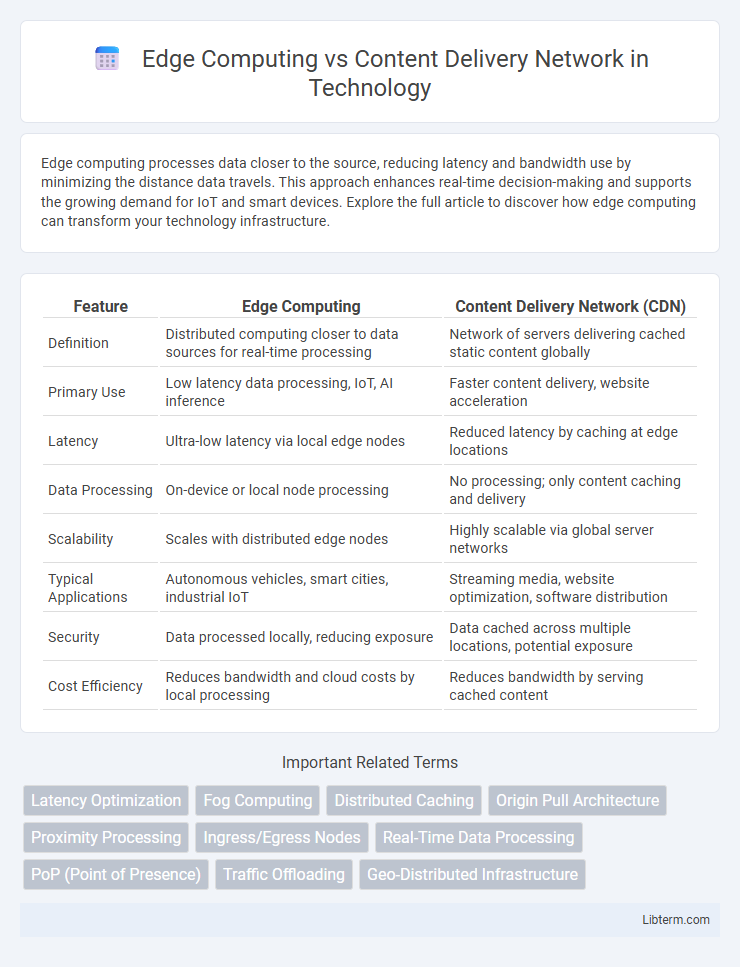Edge computing processes data closer to the source, reducing latency and bandwidth use by minimizing the distance data travels. This approach enhances real-time decision-making and supports the growing demand for IoT and smart devices. Explore the full article to discover how edge computing can transform your technology infrastructure.
Table of Comparison
| Feature | Edge Computing | Content Delivery Network (CDN) |
|---|---|---|
| Definition | Distributed computing closer to data sources for real-time processing | Network of servers delivering cached static content globally |
| Primary Use | Low latency data processing, IoT, AI inference | Faster content delivery, website acceleration |
| Latency | Ultra-low latency via local edge nodes | Reduced latency by caching at edge locations |
| Data Processing | On-device or local node processing | No processing; only content caching and delivery |
| Scalability | Scales with distributed edge nodes | Highly scalable via global server networks |
| Typical Applications | Autonomous vehicles, smart cities, industrial IoT | Streaming media, website optimization, software distribution |
| Security | Data processed locally, reducing exposure | Data cached across multiple locations, potential exposure |
| Cost Efficiency | Reduces bandwidth and cloud costs by local processing | Reduces bandwidth by serving cached content |
Introduction to Edge Computing and Content Delivery Networks
Edge computing processes data closer to the source, reducing latency and improving real-time performance by leveraging local devices and servers. Content Delivery Networks (CDNs) enhance website speed and reliability by distributing cached content across geographically dispersed servers. Both technologies optimize data handling, with edge computing focusing on computation near data generation and CDNs concentrating on efficient content distribution.
Core Differences Between Edge Computing and CDN
Edge computing processes data near the source of data generation, enabling real-time analytics, reduced latency, and improved bandwidth efficiency by minimizing data transmission to centralized servers. Content Delivery Networks (CDNs) primarily focus on caching and delivering static content such as images, videos, and web pages from geographically distributed servers to enhance website loading speed and availability. The core difference lies in functionality: edge computing supports complex computations and dynamic data processing at the network edge, while CDNs optimize content delivery through distribution and caching techniques.
How Edge Computing Works
Edge computing processes data locally on distributed devices near the data source, reducing latency and bandwidth usage by minimizing data sent to central servers. This approach enables real-time analytics and faster response times by executing computations directly at the network edge, such as IoT devices or local edge servers. In contrast, Content Delivery Networks primarily cache and deliver web content from strategically placed nodes to improve load speeds without performing extensive data processing.
How Content Delivery Networks Operate
Content Delivery Networks (CDNs) operate by distributing cached content across a global network of strategically located edge servers, reducing latency and improving load times for users by delivering data from the nearest node. These servers store static assets like images, videos, and web pages, reducing the origin server's load and enhancing website performance. CDNs also optimize content delivery through intelligent routing, load balancing, and real-time analytics to ensure high availability and scalability.
Key Benefits of Edge Computing
Edge computing enhances real-time data processing by bringing computation closer to data sources, minimizing latency and reducing bandwidth use. It improves application performance and reliability, crucial for IoT devices, autonomous vehicles, and industrial automation. Unlike traditional content delivery networks that primarily cache static content, edge computing supports dynamic data handling and complex analytics at the network edge.
Advantages of Using Content Delivery Networks
Content Delivery Networks (CDNs) offer significant advantages in distributing web content efficiently by caching data across multiple geographically dispersed servers, reducing latency and improving load times for users worldwide. CDNs provide enhanced scalability and reliability by automatically rerouting traffic during high demand or server failures, ensuring consistent content availability. Their ability to offload traffic from origin servers also reduces bandwidth costs and enhances security through built-in DDoS protection and SSL/TLS encryption.
Use Cases: Edge Computing vs CDN
Edge computing excels in real-time data processing for applications such as IoT devices, autonomous vehicles, and industrial automation, where low latency and immediate analytics are critical. Content Delivery Networks (CDNs) specialize in distributing static and dynamic web content, streaming media, and software updates by caching data closer to users to improve load times and reduce bandwidth usage. Use cases for edge computing emphasize computation near the data source, while CDNs prioritize efficient content distribution across geographies.
Performance and Latency Comparisons
Edge computing processes data closer to the source by leveraging localized servers and devices, significantly reducing latency and improving real-time performance for applications like IoT and autonomous systems. Content Delivery Networks (CDNs) optimize content distribution by caching static resources across global edge locations, enhancing load times primarily for web content but often involving slightly higher latency compared to direct edge computing nodes. Performance gains in edge computing arise from localized computation and minimal data travel, whereas CDNs excel in accelerating content delivery through geographically distributed caches but may face latency spikes during cache misses or dynamic content requests.
Security Implications of Edge Computing and CDNs
Edge computing processes data closer to the source, reducing latency but increasing exposure to physical tampering and insecure edge nodes. Content Delivery Networks (CDNs) enhance security by distributing content through multiple encrypted nodes, mitigating DDoS attacks and improving data integrity. Both architectures require robust encryption, authentication protocols, and real-time threat detection to address unique vulnerabilities in decentralized environments.
Future Trends in Edge Computing and Content Delivery Networks
Future trends in edge computing emphasize increased integration with AI and IoT to enable real-time data processing closer to end-users, reducing latency and enhancing user experiences. Content Delivery Networks (CDNs) are evolving by incorporating edge computing capabilities to support dynamic content delivery, improve scalability, and secure data transmission. The convergence of edge computing and CDNs will drive advancements in 5G deployment, autonomous systems, and smart city applications, reshaping digital infrastructure.
Edge Computing Infographic

 libterm.com
libterm.com